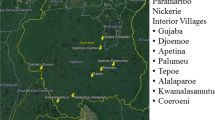Abstract
Elemental mercury is used in folk medicine and in certain religious practices in the Latin American and Caribbean communities. However, exposure to mercury can cause serious health problems including neurotoxicity. There are, therefore, concerns that mercury users are exposing themselves to dangerous levels of this toxicant. A survey was conducted to determine the use pattern of elemental mercury in the Latin American and Caribbean communities in New York City. Two hundred and three adults participated in the survey. Forty-four percent of the respondents from the Caribbean and 27% from Latin America stated that they have knowledge of such cultural uses.
Similar content being viewed by others
REFERENCES
Agency for Toxic Substances and Disease Registry (ATSDR). (1994). Use of azogue (metallic mercury) in santeria practices of residents of Hartford, Connecticut. U.S. Public Health Service, Atlanta, Georgia.
Agency for Toxic Substances and Disease Registry (ATSDR). (1997). National alert: Warning about continuing patterns of metallic mercury exposure. Atlanta, Georgia.
Berlin, M. (1986). Mercury. In L. Friberg, G. R. Nordberg & V. B. Vouk (Eds.): Handbook on the toxicology of metals (2nd ed.). New York: Elsevier Press.
Cotton, F. A. & Wilkinson, G. (1972). Advanced inorganic chemistry (3rd. ed.). New York: John Wiley & Sons, Inc.
Dencker, L., Danielsson, B., & Khayat, A. (1983). Deposition of metals in the embryo and fetus. In T. W. Clarkson, G.G. Nordberg & P. R. Sager, (Eds.). Reproductive and development toxicity of metals, pp. 607-631. New York: Plenum Press.
Environmental Protection Agency (1996). Mercury study report to Congress. (EPA publication No. 452-R-96-001). Washington: U.S. Government Printing Office.
Fagala, G. E., & Wigg, C. L. (1992). Psychiatric manifestations of mercury poisoning. J. Am. Acad. Child. Adolesc. Psychiat. 31, 306-311.
Goldwater, L. J. (1972). Mercury—A history of quicksilver, Baltimore, MD: York Press, Inc.
Hallee, T. J. (1969). Diffuse lung disease caused by inhalation of mercury vapor. Am. Rev. Respir. Dis. 99, 430-436.
Karpathios, T., Zervoudakis, A. & Thodoridis, C. (1991). Mercury vapor poisoning associated with hyperthyroidism in a child. Acta. Paediatric. Scanddinavia. 80, 551-552.
Klaassen, C. D., Amdur, M. O. & Doull, J. (1986). Toxicology, the basic science of poison (3rd. ed.). New York: Macmillan.
Hursh, J. B., Clarkson, T. W. & Miles, E. F. (1989). Percutaneous absorption of mercury vapor by man. Archives of Environmental Health 44, 120-127.
Hursh, J. B. (1985). Partition coefficients of mercury (203Hg) vapor between air and biological fluids. Journal of Applied Toxicology 5, 327-332.
Hursh, J. B., Clarkson, T. W., Nowak, T. V., Pabicio, R. C., Mc Kenna, B. A., Miles, E. & Gibb, F. R. (1985). Prediction of kidney mercury content by isotope techniques. Kidney International. 27, 898-907.
Oikawa, K., Saito, H., Kufune, I., Ohshina, T., Fujii, M. & Takizawa, Y. (1982) Mercury absorption by inhalation through the nose and expiring through the mouth at various concentrations. Chemosphere 11, 943-951.
Schwartz, J. G., Snider, T. E. & Montiel, M. M. (1992) Toxicity of a Family from vacuumed mercury, American Journal of Emergency Medicine. 10, 258-261.
Snodgrass, W., Sullivan, J. B., Rumack, B. H., et al. (1981). Mercury poisoning from home gold ore processing: use of penicillamine and dimercaprol J. Am. Med. Assoc. 246, 1929-1931.
Taueg, C., Sanfilippo, D. J., & Rowens, B., Szejda, J. & Hesse, J. L. (1992). Acute and chronic poisoning from residential exposures to elemental mercury. J. Toxicol. Clin. Toxicol. 30, 63-67.
Author information
Authors and Affiliations
Rights and permissions
About this article
Cite this article
Johnson, C. Elemental Mercury Use in Religious and Ethnic Practices in Latin American and Caribbean Communities in New York City. Population and Environment 20, 443–453 (1999). https://doi.org/10.1023/A:1023361018965
Issue Date:
DOI: https://doi.org/10.1023/A:1023361018965




